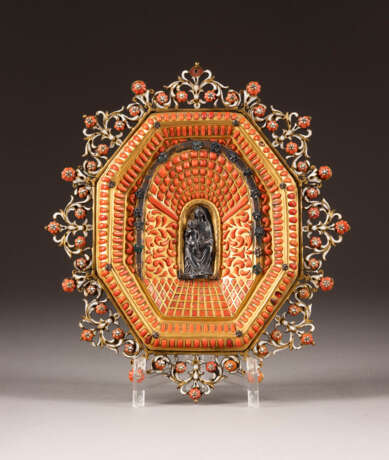ID 805627
Lot 1100 | MUSEALES CAPEZZALE (ANDACHTSBILD) MIT DER THRONENDEN MADONNA MIT KIND
Estimate value
€ 1 200
Sizilien, Trapani, Mitte 17. Jh.
Silber, Kupfer, vergoldet und graviert, Bronze, gegossen, Korall-Intarsien, weißes Opakemail. 23,5 x 21 cm. Im Zentrum thront die im Hochrelief aus Silber gearbeitete Maria mit dem Jesuskind in ihrem Schoß. Feine, perspektivisch angeordnete Intarsien in Koralle entourieren das Mittelfeld und erzeugen eine Tiefenwirkung. Der ornamental durchbrochen gearbeitete Rahmen ist weiß emailliert und mit Korallblüten besetzt. Die Rückseite trägt mittig das Gravurmonogramm 'AM' unter Krone und wird von ornamentalem Beschlagwerk gerahmt. Kleine Fehlstellen, Koralle teils min. rest., Email min. best.
Der alte Fischereihafen von Trapani an der Westküste Siziliens war vom 16. bis ins 18. Jahrhundert für die Herstellung von Gegenständen aus roter Koralle bekannt. Am weitesten verbreitet waren die capezzale, Andachtstafeln mit religiösen Figuren in gravierten Kupferrahmen mit reichen Korallintarsien und Emailverzierungen. Andere Arbeiten umfassten liturgische Gegenstände wie Kelche und Kruzifixe sowie weltliche Objekte wie Schmuck, Tintenfässer und kleine Schatullen, von denen viele ihren Weg in europäische Kunstkammern fanden. Im Laufe des 17. Jahrhunderts entwickelte sich Trapani zu einem der führenden Zentren für die Herstellung von Kunstwerken aus Korallen. Aufgrund der geografischen Lage und der Nutzung der natürlichen Ressourcen und der ausgedehnten Korallenbänke, die bis weit ins 18. Jahrhundert hinein andauerte, wurde Trapani zu einem der wichtigsten Handelshäfen im Mittelmeerraum. Dieses Wachstum führte zur Ausbreitung einer wohlhabenden Kaufmannsschicht, die zusammen mit dem wohlhabenden Klerus zur Entwicklung und zum Wachstum eines hohen Niveaus der Korallen- und Goldschmiedekunst beitrug. Im Jahr 1628 wurde in Trapani die Gilde der Korallenarbeiter, die Arte dei Corallari, gegründet. Nach der Niederschlagung des dortigen Aufstands im Jahr 1672 wurden die spezialisierten Korallenarbeiter in andere Mittelmeerzentren verstreut.
| Auction house category: | Silver & Silver plated |
|---|
| Auction house category: | Silver & Silver plated |
|---|
| Address of auction |
Hargesheimer Kunstauktionen Düsseldorf Friedrich-Ebert-Strasse 11+12 40210 Düsseldorf Germany | ||||||||||||||
|---|---|---|---|---|---|---|---|---|---|---|---|---|---|---|---|
| Preview |
| ||||||||||||||
| Phone | +49 (0) 2113020010 | ||||||||||||||
| Fax | +49 (0) 21130200119 | ||||||||||||||
| Buyer Premium | 28.56% | ||||||||||||||
| Conditions of purchase | Conditions of purchase | ||||||||||||||
| Shipping |
Postal service pickup by yourself | ||||||||||||||
| Payment methods |
Wire Transfer | ||||||||||||||
| Business hours | Business hours
|



